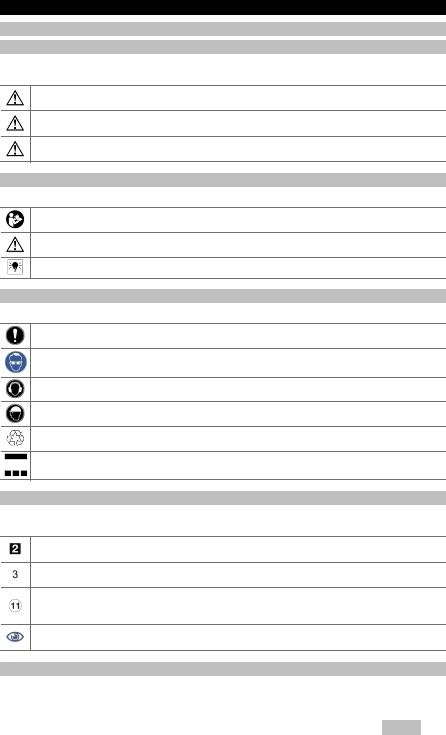Hilti BX 3-ME, BX 3-IF User Manual

BX 3-ME BX 3-IF
English
Printed: 24.08.2016 | Doc-Nr: PUB / 5269959 / 000 / 02
Printed: 24.08.2016 | Doc-Nr: PUB / 5269959 / 000 / 02

1 Information about the documentation
1.1 Explanation of signs used
1.1.1 Warnings
Warnings alert persons to hazards that occur when handling or using the product. The following signal words are used in combination with an icon:
DANGER! Draws attention to imminent danger that will lead to serious personal injury or fatality.
WARNING! Draws attention to a potentially dangerous situation that could lead to serious personal injury or fatality.
CAUTION! Draws attention to a potentially dangerous situation that could lead to minor personal injury or damage to the equipment or other property.
1.1.2 Symbols
The following symbols are used in this document:
Read the operating instructions before use.
General warning
Instructions for use and other useful information
1.1.3 Symbols on the product
The following symbols are used on the product:
General mandatory sign
Wear eye protection
Wear ear protection
Wear a hard hat
Return waste material for recycling
Direct current (DC)
1.1.4 Characters used in illustrations
The illustrations in these operating instructions are intended to promote a better understanding and may deviate from the actual version of the product.
These numbers refer to the corresponding illustrations found at the beginning of these operating instructions.
The numbering in the illustrations reflects the order of the work steps in the illustration and may deviate from the numbering of work steps in the text.
Item reference numbers are used in the overview illustration and refer to the numbers used in the product overview section. In the product overview section, the numbers shown in the legend relate to these item reference numbers.
These characters are intended to specifically draw your attention to certain points when handling the product.
1.2About this documentation
Read these operating instructions before the product is used or operated for the first time. This is a prerequisite for safe, trouble-free handling and use of the product.
English 1
Printed: 24.08.2016 | Doc-Nr: PUB / 5269959 / 000 / 02

Observe the safety instructions and warnings in this documentation and on the product.
This document forms a permanent, integral part of the product described and must always be with the product when it is handed over to other persons.
1.3Product information
Hilti products are designed for professional use and may be operated, serviced and maintained only by trained, authorized personnel. This personnel must be informed of any particular hazards that may be encountered. The product and its ancillary equipment may present hazards when used incorrectly by untrained personnel or when used not as directed. The type designation and serial number are printed on the type identification plate.
Write down the serial number in the table below. You will be required to state the product details when contacting Hilti Service or your local Hilti organization to enquire about the product.
Product information
Type: |
BX 3-ME | BX 3-IF |
Generation: |
01 |
Serial number: |
|
2 Safety
2.1 Safety instructions
The safety instructions given in the following section contain all the general safety instructions for power tools which are to be listed in the operating instructions in accordance with the applicable standards. As a result, some of the instructions listed may not be relevant to this tool.
2.1.1 General power tool safety warnings
 WARNING
WARNING
Read all safety warnings and all instructions. Failure to follow the warnings and instructions may result in electric shock, fire and/or serious injury.
Save all warnings and instructions for future reference.
The term “power tool” in the warnings refers to your mains-operated (corded) power tool or battery-operated (cordless) power tool.
Work area safety
Keep work area clean and well lit. Cluttered or dark areas invite accidents.
Do not operate power tools in explosive atmospheres, such as in the presence of flammable liquids, gases or dust. Power tools create sparks which may ignite the dust or fumes.
Keep children and bystanders away while operating a power tool. Distractions can cause you to lose control.
Electrical safety
Power tool plugs must match the outlet. Never modify the plug in any way. Do not use any adapter plugs with earthed (grounded) power tools. Unmodified plugs and matching outlets will reduce risk of electric shock.
Avoid body contact with earthed or grounded surfaces, such as pipes, radiators, ranges and refrigerators. There is an increased risk of electric shock if your body is earthed or grounded.
Do not expose power tools to rain or wet conditions. Water entering a power tool will increase the risk of electric shock.
Do not abuse the cord. Never use the cord for carrying, pulling or unplugging the power tool. Keep cord away from heat, oil, sharp edges or moving parts. Damaged or entangled cords increase the risk of electric shock.
When operating a power tool outdoors, use an extension cord suitable for outdoor use. Use of a cord suitable for outdoor use reduces the risk of electric shock.
If operating a power tool in a damp location is unavoidable, use a residual current device (RCD) protected supply. Use of an RCD reduces the risk of electric shock.
Personal safety
Stay alert, watch what you are doing and use common sense when operating a power tool. Do not use a power tool while you are tired or under the influence of drugs, alcohol or medication. A moment of inattention while operating power tools may result in serious personal injury.
2 English
Printed: 24.08.2016 | Doc-Nr: PUB / 5269959 / 000 / 02

Use personal protective equipment. Always wear eye protection. Protective equipment such as dust mask, non-skid safety shoes, hard hat, or hearing protection used for appropriate conditions will reduce personal injuries.
Prevent unintentional starting. Ensure the switch is in the off position before connecting to power source and/or battery pack, picking up or carrying the tool. Carrying power tools with your finger on the switch or energising power tools that have the switch on invites accidents.
Remove any adjusting key or wrench before turning the power tool on. A wrench or a key left attached to a rotating part of the power tool may result in personal injury.
Do not overreach. Keep proper footing and balance at all times. This enables better control of the power tool in unexpected situations.
Dress properly. Do not wear loose clothing or jewellery. Keep your hair, clothing and gloves away from moving parts. Loose clothes, jewellery or long hair can be caught in moving parts.
If devices are provided for the connection of dust extraction and collection facilities, ensure these are connected and properly used. Use of dust collection can reduce dust-related hazards.
Power tool use and care
Do not force the power tool. Use the correct power tool for your application. The correct power tool will do the job better and safer at the rate for which it was designed.
Do not use the power tool if the switch does not turn it on and off. Any power tool that cannot be controlled with the switch is dangerous and must be repaired.
Disconnect the plug from the power source and/or the battery pack from the power tool before making any adjustments, changing accessories, or storing power tools. Such preventive safety measures reduce the risk of starting the power tool accidentally.
Store idle power tools out of the reach of children and do not allow persons unfamiliar with the power tool or these instructions to operate the power tool. Power tools are dangerous in the hands of untrained users.
Maintain power tools. Check for misalignment or binding of moving parts, breakage of parts and any other condition that may affect the power tool’s operation. If damaged, have the power tool repaired before use. Many accidents are caused by poorly maintained power tools.
Keep cutting tools sharp and clean. Properly maintained cutting tools with sharp cutting edges are less likely to bind and are easier to control.
Use the power tool, accessories and tool bits etc. in accordance with these instructions, taking into account the working conditions and the work to be performed. Use of the power tool for operations different from those intended could result in a hazardous situation.
Battery tool use and care
Recharge only with the charger specified by the manufacturer. A charger that is suitable for one type of battery pack may create a risk of fire when used with another battery pack.
Use power tools only with specifically designated battery packs. Use of any other battery packs may create a risk of injury and fire.
When battery pack is not in use, keep it away from other metal objects, like paper clips, coins, keys, nails, screws or other small metal objects, that can make a connection from one terminal to another. Shorting the battery terminals together may cause burns or a fire.
Under abusive conditions, liquid may be ejected from the battery; avoid contact. If contact accidentally occurs, flush with water. If liquid contacts eyes, additionally seek medical help. Liquid ejected from the battery may cause irritation or burns.
Service
Have your power tool serviced by a qualified repair person using only identical replacement parts.
This will ensure that the safety of the power tool is maintained.
2.1.2Tacker safety warnings
Always assume that the tool contains fasteners. Careless handling of the fastening tool can result in unexpected firing of nails causing personal injury.
Do not point the tool towards yourself or anyone nearby. A nail will be ejected by the tool if it is triggered unexpectedly, possibly leading to injury.
Do not actuate the tool unless the tool is placed firmly against the workpiece. If the tool is not in contact with the workpiece, the fastener may be deflected away from your target.
Disconnect the tool from the power source when the fastener jams in the tool. While removing a jammed fastener, the fastening tool may be accidentally activated if it is plugged in.
Use caution while removing a jammed fastener. The mechanism may be under tension and the nail may be forcefully ejected while attempting to free a jam.
English 3
Printed: 24.08.2016 | Doc-Nr: PUB / 5269959 / 000 / 02

BX 3-ME
When fastening electrical cables, make sure the cables are not energized. Hold the fastening tool only by insulated gripping surfaces. Use only fasteners designed for electrical cable installations. Check that the fastener has not damaged the insulation of the electrical cable. A nail that damages the insulation of electric cables can lead to electric shock and fire hazards.
BX 3-IF
Do not use this fastening tool to fasten electric cables. It is not suitable for the installation of electric cables as damage to the insulation on the electric cables may be caused, thus resulting in a risk of electric shock and fire hazards.
2.1.3 Additional safety instructions
Working safely and carefully with the fastening tools
Do not tamper with or modify the tool.
Do not damage the casing of the tool when applying identification marks.
Always remove the battery and fasteners before breaks between working, before cleaning, care or maintenance and before storage or transport.
Store tools in a secure place when not in use. When not in use, tools must be stored in a dry, high place or locked away out of reach of children.
Keep your arms flexed when operating the tool (do not straighten the arms).
Pull the safety trigger only when the tool is pressed against the workpiece at right angles and when the edge distance and fastener spacing distance have been observed (see technical data sheet for the nail).
Always hold the tool securely and at right angles to the workpiece when driving fasteners. This will help to prevent fasteners being deflected by the workpiece.
Never trigger the tool again in an attempt to improve the hold of a previously driven nail or stud.
Fasteners can break or jam.
Do not drive fasteners into existing holes except in situations where this is recommended by Hilti.
Always observe the application guidelines.
Do not grip or hold the tool by the nosepiece.
Do not use the magazine as a grip.
Do not use the tool as a hammer.
Never drop the tool.
A nail will be ejected by the tool if it is triggered inadvertently, possibly leading to injury. Never press the nose of the tool against your hand or other part of your body or the body of another person. In the event of a malfunction, remove the battery, press the nose of the tool against the workpiece and pull the safety trigger.
Do not cover the ventilation slots on the tool, e.g. when working using both hands, to prevent the tool from overheating.
If the tool has overheated, allow it to cool down. Do not exceed the specified maximum fastener driving rate.
Never use the tool if the applicable safety devices have been damaged or removed.
Careful use of battery-powered tools
Observe the special guidelines applicable to the transport, storage and use of Li-ion batteries.
Do not expose batteries to high temperatures and keep them away from fire. There is a risk of explosion.
Do not disassemble, squash or incinerate batteries and do not subject them to temperatures over 80 °C (176 °F). There is otherwise a risk of fire, explosion or chemical burns.
Use only batteries of the type approved for use with the applicable tool. Use of other batteries or use of the batteries for purposes for which they are not intended presents a risk of fire and explosion.
Do not use the battery as a power source for other unspecified power tools.
Do not apply excessive force when fitting or removing the battery.
Do not attempt to continue to use or charge damaged batteries (e.g. batteries with cracks, broken parts or bent or distorted contacts).
Avoid short circuiting the battery terminals. Check that the contacts on the battery and on the tool are free from foreign objects before inserting the battery into the tool. Short circuiting the battery terminals presents a risk of fire, explosion and chemical burns.
Do not use the tool in wet weather (rain) or in damp conditions.
4 English
Printed: 24.08.2016 | Doc-Nr: PUB / 5269959 / 000 / 02

Avoid ingress of moisture. Ingress of moisture may cause a short circuit, resulting in burning injuries or fire.
Workstation
Do not attempt to drive fasteners into materials that are too hard, such as welded steel or cast steel. Attempting to drive fasteners into these materials may lead to malfunctions, incorrectly driven fasteners or breakage of fasteners.
Do not attempt to drive fasteners into materials that are too soft, such as wood or plasterboard.
Attempting to drive fasteners into these materials may lead to malfunctions and fasteners being driven incorrectly or driven right through the material.
Do not attempt to drive fasteners into materials that are too brittle, such as glass or tiles. Attempting to drive fasteners into these materials may lead to malfunctions, fasteners being driven incorrectly and may cause the material to shatter.
Before driving fasteners, check that there is no risk of injuring persons or of damaging objects present behind or below the workpiece.
Keep the grips dry, clean and free from oil and grease.
Dust from materials such as paint containing lead, some types of wood, concrete, masonry and stone containing quartz, as well as minerals and metals, may present health risks. Contact with or inhalation of the dust may cause allergic reactions and/or respiratory or other diseases among operators or bystanders. Certain kinds of dust such as oak and beech wood dust are classified as carcinogenic, especially in conjunction with additives for wood conditioning (chromate, wood preservative). Materials containing asbestos may be handled only by specialists. Use a dust-extraction device wherever possible. When indicated, wear a respirator appropriate for the type of dust generated. Ensure that the workplace is well ventilated. Follow national requirements for the materials you want to work with.
Mechanical safety rules
Use only fasteners of a type approved for use with the tool.
Personal safety
Wear ear protectors. Exposure to noise can cause hearing loss.
Improve the blood circulation in your fingers by relaxing your hands and exercising your fingers during breaks between working.
The tool is not intended for use by persons who have not received special training. Keep the tool out of reach of children.
Wear protective gloves to prevent the hands from chafing with frequent use of the tool.
Electrical safety
Concealed electrical cables or gas and water pipes present a serious hazard if damaged while you are working. Before beginning the work, check the working area for concealed electrical cables, gas and water pipes, e.g. using a metal detector. External metal parts of the power tool may become live, for example, when an electrical cable is damaged accidentally.
English 5
Printed: 24.08.2016 | Doc-Nr: PUB / 5269959 / 000 / 02
